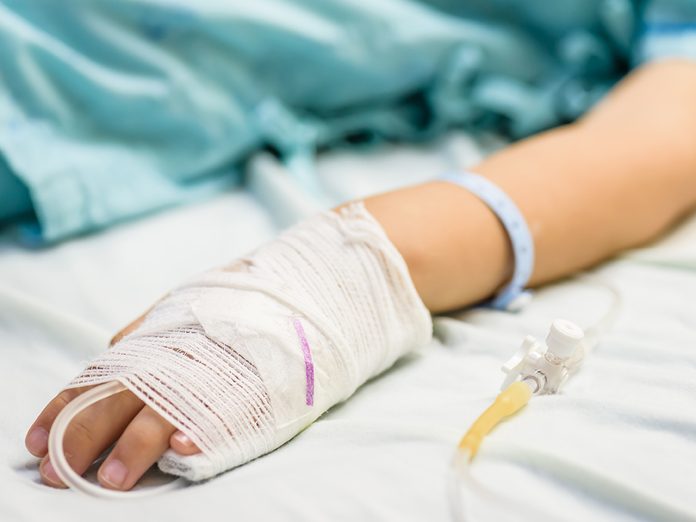
What’s wrong with me?
The patient: Sophie (name has been changed), a 10-year-old girl
The symptoms: Intense abdominal pain and spine curvature
The doctor: Dr. Charles G. Stewart, pediatric emergency physician at Chelsea and Westminster Hospital, London, England
Sophie was an active 10-year-old who enjoyed playing netball in her southwest London neighbourhood. In early November 2016, she picked up a mild cold virus from her older brother. Although she felt tired and sick for a couple of days, she appeared to bounce back.
Two weeks later, Sophie developed a sharp pain in her right side—one that became more intense when she moved or lay down. When she couldn’t get comfortable at bedtime, her concerned parents brought her to Chelsea and Westminster Hospital.
Sophie’s abdomen was examined for signs of appendicitis, but it felt normal. She wasn’t feverish. With only one symptom to go on, making a diagnosis was challenging, and her doctors thought she might have simply pulled a muscle while she was playing sports. Sophie was given acetaminophen—which seemed to lessen her pain somewhat—and then was sent home. Her parents were told they should bring Sophie back for X-rays if she didn’t improve.
The next few hours were wretched, recalls her mom, Joanne. “Sophie couldn’t sleep at all that night, and medication couldn’t relieve the pain.” First thing in the morning, the family was back in the ER for more tests.

A mystery pain
But an abdominal ultrasound was completely normal, and a chest X-ray showed nothing more than a mild scoliosis, or curvature of the spine. That’s not uncommon in a girl who might be having a growth spurt. “It was not thought to be significant,” says Dr. Charles G. Stewart, who works in the hospital’s Department of Paediatric Emergency.
Sophie’s breathing rate and pulse were slightly faster than they had been the night before, but that could simply mean she was in more discomfort. The surgical consultants maintained that a musculoskeletal injury was still the most likely cause of the pain. Sophie’s parents weren’t convinced but didn’t know what else it could be. Once again, they were sent away with acetaminophen and instructions to come right back if she didn’t start feeling better soon.
At home, the abdominal pain only intensified. Sophie spent that night curled up on the sofa, screaming in agony. She started shivering, and vomited. “It was clear there was something seriously wrong,” says Joanne. The next day, as the family rushed to get ready to go back to the hospital, Joanne noticed something odd: Sophie was bending over sideways and limping, as though one leg were shorter than the other.
Doctors in the ER could now see that Sophie was quite ill. She was pale, and her heart rate was even higher. Her C-reactive protein count—which can signify inflammation—had quadrupled in two days. And, as Joanne had noticed, her standing posture was very strange, with her right leg a bit bent as she leaned on her left side. She needed to be admitted. “We couldn’t send the girl home again,” Stewart says, “but we didn’t have a clear line on what was going on.”
A range of conditions, from bone infection to leukemia, might cause Sophie’s spine to bend. But an orthopedic team assessed Sophie and found nothing.
Finally, the doctors decided to conduct a CT scan of Sophie’s abdomen to look for the source of the pain. This type of X-ray takes a series of detailed images as cross-sections. Fortuitously, one of these cross-sections caught the lowest portion of Sophie’s right lung. That image provided the answer: Sophie had pneumonia.
Here are 20 symptoms you should never ignore.

A surprising diagnosis
There’s no way to know how Sophie picked up this bacterial invasion; her immunity could have been down from fighting her cold. As many as one in 20 kids who see a doctor for abdominal pain actually have pneumonia, particularly if the infection is in the lower lobe of the lung. And in fact, pneumonia is the number one cause of child mortality worldwide, especially in regions without adequate health care. But it’s rare for abdominal pain to be the only complaint. Pneumonia typically causes coughing and wheezing. It also comes with a fever, although that can be suppressed if the patient takes acetaminophen, as Sophie did.
Although Sophie had been given a chest X-ray earlier, 27 percent of these look normal in the early stages of pneumonia, says Stewart, because lung inflammation may not show up well in the two-dimensional images. The scoliosis was more telling—and that was caused simply by the way Sophie was holding herself. “Without realizing it, Sophie was adopting a posture to quell the pain of the pneumonia,” says Stewart.
Stewart adds that pneumonia symptoms aren’t always predictable. “We were tricked by this devious presentation.” Nevertheless, he has sympathy for the frustrated parents, who watched their child suffer without a diagnosis. “I think a lot of people assume, in an age of AI and cloud computing, that medicine is easy, but it’s not.”
Doctors started Sophie on intravenous antibiotics but she developed fluid around her lungs and needed a chest drain. She went home two weeks later, and four months after that, she had recovered the energy to return to school full-time. “We were just relieved that she was improving, without any setbacks,” says Joanne.
Meeting Sophie has had a lasting impact on Stewart. “I’ve referenced her many times with my junior doctors: in the absence of everything else, abdominal pain with scoliosis should make you think of a postural response to pneumonia,” he says.
Next, find out what was behind this young girl’s mysterious muscle spasms.